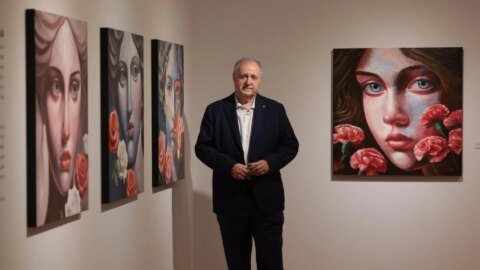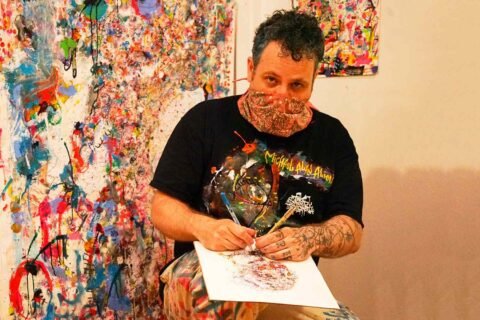
Describing Caleb Hahne Quintana’s paintings as figurative feels reductive. With extraordinary command of brush and light, his work occupies an untamed space between lived experience and the subconscious undercurrents that accompany it. He distills scenes of deep emotional and psychological resonance, staging archetypal situations and literary tropes that run through the history of civilization. And by tapping into the mythological realm, he allows these scenes to move beyond personal or autobiographical reflection, extending into the universal questions that have always accompanied human existence.
This mythological and highly symbolic approach to figuration is especially evident in the new body of work Quintana is presenting in his solo show at Anat Ebgi Gallery in New York. Titled “A Boy That Don’t Bleed,” the series reflects both a personal and universal exploration aimed at challenging the myth of masculine invulnerability—a myth that forces men, from a young age, into a social performance that denies emotional and physical vulnerability. “One of the things I run into often with my work is that people assume I’m queer, even though I’m not. I think that’s a testament to the way we sometimes perceive—or expect—straight men not to be vulnerable or emotional,” Quintana told Observer when we met in his Brooklyn studio before the paintings made their way to the gallery.
For Quintana, this is at the core of the ongoing crisis of masculinity. “The exhibition is a meditation on that kind of crisis, on being confronted with the self at a young age without necessarily being given the tools, the space, the language or an outlet to process it,” he explains. “There are moments of tragedy, moments of peace, moments of pondering, moments of solitude and moments of anger in the exhibition that I’m trying to address. And those moments are where you can question the meaning of life.”


The show’s title comes from a poem Quintana wrote, and as it suggests, the poem raises the question of whether the boy has been wounded. “There’s this kind of surreal quality in the sense that he’s either been hurt or can’t be hurt,” the artist explained. “And I think that raises another question about this belief that men, or young men, can be impervious to certain kinds of damage.”
Both physical and psychological fragility surface in the men Quintana paints, framed within the introspective space of their loneliness. They appear in vast, open landscapes, left to contemplate their scale and place within the universe. He takes the viewer on a journey that follows the growth of a young boy into a man, embarking on an odyssey of inner awakening and self-realization.
Yet the boy is never individualized. His facial features remain deliberately undefined—obscured by atmosphere, light or scale. What matters most is not his individual story but his potential to serve as an alter ego, a blank surface onto which the viewer can project their own existential search for meaning. “That’s also been the magic of these paintings,” Quintana said. “They force and arrest the viewer, making them resolve the image in a new way.”
Light and shadow function not just as compositional tools but as narrative forces, drawing attention to symbolic elements in each scene. These elements define the figure’s search for meaning—one that requires both introspection and outward observation. “For the first time in my work, I’ve treated every single component with equal weight,” Quintana reflected.
What Quintana describes is more psychological than physical, as he uses painting to probe the mysteries of selfhood and the unconscious. While in earlier works the boy felt more directly tied to the artist, here he remains unnamed and faceless. “They’re self-portraits because they’re about the self, but I don’t treat them as such. It’s this other psychological space I’m more interested in—one that connects to a broader sense of consciousness and coalescence.”


Quintana is drawn to the inherent absurdity embedded in even the most mundane moments. “I realized I wasn’t the only one experiencing this kind of grand absurdity,” he reflected, adding that he finds it absurd to believe that an artist could ever create something never seen before. Instead, he gravitates toward familiar subjects—much like Andrew Wyeth, whose ability to imbue the everyday with profound honesty deeply resonates with him.
Although his work has always drawn from the mundane—quiet, seemingly ordinary scenes reframed as deeply personal, whether it’s dozing in a cave, diving, reading or walking through a park—he is now attempting to elevate them into something almost surreal. A short poem on the wall reads, “The familiar is important for the uncanny.”
What continues to interest him is the tension between the familiar and the absurd—those quiet moments that, when closely observed, reveal something stranger beneath the surface. “I felt a deep emotional connection to the earth, the world, and my place in it, and I began to see my role as an observer—as a vessel—to highlight those shared experiences,” he said. “That’s also why I work from the type of imagery and memory that I do, because I don’t believe my experience is entirely individual.”


In an intriguing metalinguistic gesture, Quintana has introduced a narrator into his work—its face and identity obscured by shadow, standing at the threshold of the show. He initially painted remnants of a face but found it dissolved the mystery. “I realized I needed to give the viewer fewer answers and let them resolve the painting on their own.” He describes this figure as an unreliable narrator—someone offering a version of events but from an elevated, distant perspective. The role of this narrator is to allow the viewer to move beyond the immediacy of the scene and enter a broader, more universal space of contemplation.
One of the brightest paintings in the show depicts a monumental figure seen from behind, gazing at its own shadow cast across a radiant yellow ground. The canvas bursts with energetic brushwork—an exciting departure from Quintana’s typically smooth, densely saturated surfaces. Within the shadow lies an infinite array of gradients, suggesting that even darkness holds light. “This painting is about consciousness and the shadow self. I like this idea of discovering the shadow in a more Platonic way, and your shadow in a Jungian reading,” Quintana explained. “But I also treated this shadow as having just as much soul as the man himself, maybe even more—like a pulsing heart within the earth.”


This work signals Quintana’s deeper engagement with the joy of painting, unleashing the full expressive potential of varied gestures and surface treatments. “This is the thickest my paintings have ever been in terms of material,” he reflected. “I used to paint quite thin, but now I’m just obsessed with paint—its ability to hold so much history even in a single surface. When you get up close, it’s like sedimentation; it’s pretty abstract. And when I think about these compositions, if I were to break them down into pure color fields or abstractions, they’d essentially be abstract paintings.”
Departing from his previous use of saturated and artificial tones, Quintana’s new works are grounded in a more restricted palette, recalling the methods of old masters. “I realized that if I have twelve different types of purple, I’m going to create so many subtle variations that the eye won’t even consciously register. Reducing the palette even more, I also wanted some of these paintings to feel like they could have been painted long ago.”
In Quintana’s work, there is a sustained, deliberate dialogue with the history of painting—most notably in his dramatic use of light and shadow. His chiaroscuro heightens the intensity of each scene, echoing the legacy of Caravaggio and the Caravaggeschi school, later carried forward by artists like Francisco Goya and pushed into an epic, theatrical register.


In the painting A Flicker in the Ancient Rhythm (2025), a young boy stands beside an immense waterfall, confronting its relentless force. A white house—an archetype of permanence—serves as a sentinel, guiding the boy through his personal odyssey and helping him locate his place within the vastness of the universe. The painting evokes the spirit of Romanticism and the Hudson River School, balancing serenity and terror as the individual confronts nature’s immensity, forced to reckon with his own existential vulnerability. “We have this great beauty, this great nature—we just have to be observant,” Quintana said.
The land has long played a central role in his work, particularly in relation to his upbringing as a Mexican American in Aurora, Colorado. Elements from the Colorado landscape—such as a Jeffrey pine—anchor these scenes in the American Southwest, yet the waterfall evokes a “fictional” emotional geography, shaped by the immigrant experience and displacement. Quintana likes “taking that specificity and turning it into a kind of grand, universal location.”
In The Boy Fights Himself (2025), the Jeffrey pine reappears as a motif in a scene where a boy battles a double of himself—embodying the eternal struggle between psyche and body, heart and mind. The boy’s form mirrors the punishment endured by the tree, battered by nature’s force. “I was thinking about the wrath of nature and the wrath of man, and how each reflects the other,” the artist said.
Quintana also spoke of spending a decade in combat sports—boxing, jiu-jitsu and wrestling. “I’ve done these things that are intense and traditionally masculine. But I think it’s important to harness the power of both spaces—the intensity and the moments of solitude, silence and tenderness. I want people to question how they see that in men, just as I explore it in myself through these paintings.”


Quintana’s Mexican American identity intensifies the tension with the idea of invincible masculinity—a concept rooted in the machismo culture he grew up with—while also embracing a more sensitive, emotional side shaped by his close relationships with his mother and Mexican grandmother. His family immigrated through Mexico, where his great-great-grandmother was from, and he was raised by his Mexican mother and stepfather. “My sense of masculinity has always been through the lens of machismo,” he acknowledged. “One of the phrases I often use is ‘I’ve got to cowboy up.’”
Adopting his mother’s surname—Quintana—let him reclaim his heritage, underscoring the themes of migration, ancestry and belonging that pulse through his work. “There are moments when I need to do that—just push through something—and other moments where I have to let softness in,” he said. Notably, his great-great-grandmother was a curandera, a healer. “Since I was a kid, my grandma has always called me Karim. For her, it wasn’t just a nickname; she said it meant I had a particular heart. I’ve always felt attuned to the spiritual world, which is why these paintings carry a spiritual undertone. I’m treating all this as a vessel—observing and responding to the thoughts and feelings moving through me.”
Caleb Hahne Quintana’s “A Boy That Don’t Bleed” is on view at Anat Ebgi in New York through October 17, 2025.


More exhibition reviews





